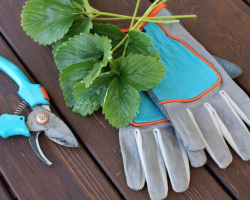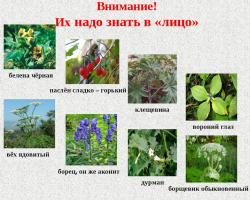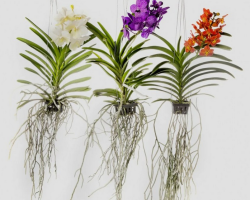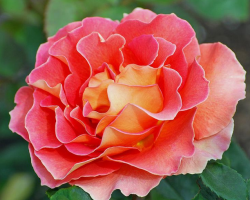How to grow a good harvest in the garden and garden? Tips for experienced gardeners and gardeners.
Content
- Council of the gardener and gardener No. 1 - correct land, care and aeration for the best crop
- Council of the gardener and gardener No. 2 - land fertilizers, organics
- Council of the gardener and gardener No. 3 - fertilizers for the Earth, minerals
- Council of the gardener and gardener No. 4-useful neighbors and cultural crops for a good harvest
- Council of the gardener and gardener No. 5 - vertical beds in the garden for the best harvest
- Council of the gardener and gardener No. 6 - distance and landing density in the garden and garden
- Council of the gardener and gardener No. 7 - fight with pests and diseases
- Council of the gardener and gardener No. 8 - How to get the best crop on warm beds?
- Council of the gardener and gardener No. 9 - Siderates to improve the quality of the crop
- Council of the gardener and gardener No. 10 - Video: Galina Kizima experience, how to get a good harvest in the garden and garden
Rich and healthy crop good help for the product basket of the family. In addition, collected vegetables, fruits, berries on their own land are much more useful than store. Scientists of the whole world have repeatedly proved this fact, but not everyone gets a good harvest. Often this is due to the characteristics of the soil, the presence of pests or adverse conditions for the growth of crops. In our article you will find useful advice from gardeners and gardeners that will help get an excellent crop.
Council of the gardener and gardener No. 1 - correct land, care and aeration for the best crop
Useful advice of gardeners and gardeners can be collected all their lives. Each culture is a separate kingdom that requires a certain care. However, a well -groomed land is necessary to grow the best crop. After all, the estate that is looked after is ideal.
- On soils with an absent fertile layer, only weeds and rare crops that do not require special processing take root. In order to get a high harvest in the garden, you need to harvest a "fertile pillow". A layer of 40-50 cm is considered ideal.
- It is good if the lands of the garden plot run in the central chernozem, but soils such as loamy, sand, lime requires constant fertilizer and top dressing. Experienced gardeners and gardeners are advised to bring substrates after harvesting or before its landing.So that they contribute to abundant shoots.
- An important procedure on the land is its aeration-differently, improving the air exchange of land, or loosening. This procedure is done immediately before the landing of cultures and as they ripen (at least 3-4 per season). So, the Earth will receive the necessary share of oxygen, which is so important at all stages of plant formation.
- The work done to improve air exchange and fertility will not be effective without watering. Do not forget about such a council as the introduction of life -giving moisture, useful for plants and the earth itself. Often in the summer there is little precipitation, and bypassing natural watering, arrange an artificial one.
- The water temperature during watering should be natural. Especially this advice should be followed immediately after planting plants in open ground. In order not to damage young shoots with cold water from the well, you should do watering in advance with a liquid. As a rule, summer residents accumulate liquid in barrels, old baths.

Council of the gardener and gardener No. 2 - land fertilizers, organics
Fertile soil with the right approach, namely when introducing land fertilizers, always brings more harvest than dilapidated lands. Often, novice landowners neglect the advice of experienced gardeners and gardeners, and after acquiring their own plot, dig it, planting it with different crops, and the crop does not bring much joy.
IMPORTANT: This situation arises due to the lack of microelements necessary for the growth of plants. Magnesium, phosphorus, nitrogen and other substances are produced at the place of growth of “correct” crops, and if the earth was covered with weed grass before the settlement of owners, then it will be necessary to carry out considerable work in fertilizing the upper layer of the Earth.
As we already wrote, cultures are developing in comfort if at least 40 cm of humus is under them. What to do if the Earth is deprived of this plot? It can be created with the help of organic fertilizers. These include manure of cows, pigs, chickens, horses.

Horse manure is considered the safestIt least contains nitrogen. But Kurin will have to work on proportions. In the case of fertilizers, the formula acts - it is better not to voluntarily than to overdo it. Otherwise, the delicate leaves of young plants will be burned by nutrients.
Among organic fertilizers, experienced gardeners use ash, peat, tops, straw, bone flour, silt, i.e. Natural material that can give the disadvantages for the growth and development of plants.
In modern stores, a wide variety of ready -made concentrated organic fertilizers has appeared, but all this natural wealth can be prepared yourself and fertilize your garden for at least 1 time. Below is a scheme for the use of organics.

Council of the gardener and gardener No. 3 - fertilizers for the Earth, minerals
Use another advice from gardeners and gardeners - use mineral fertilizers. Feeding for the Earth does not always happen in the form of ash or, suppose, in the form of straw and manure. Organic fertilizers are easily replaced by mineral. They are represented in the form of liquid concentrates, granules, powders. If you do not want to make a couple of KamAZs of a mixed mullein on your site, then it's time to make a compact top dressing from mineral fertilizers.
Inorganic fertilizers for the garden plot are both in a combined form, in combination of several components (phosphorus, nitrogen, potassium), and in monocomponents. When identifying visible deficiencies in plants, only one component is introduced. For example, with systematic yellowing of tomato leaves before planting, they should be fertilized with a solution of ammonium phosphate. Some plant diseases take place just after the introduction of a certain share of fertilizers. Apply solutions according to the instructions.
Attention! Incorrectly selected dosage of mineral fertilizer can cause exorbitant harm to the plant. Up to his death. Always follow the instructions on the back of the drug.
Foreword for trees:

Below is a list of top dressing, which are freely sold on the shelves of garden supermarkets:
- Nitrogen fertilizers - ammonium nitrate, carbamide, ammonium sulfate, superphosphate, phosphorite flour. The lack of nitrogen compounds of apple trees, strawberries, tomatoes, potatoes, cucumbers react especially vividly;
- Potassium fertilizers - potassium sulfate, potassium salt, Kalimagnesia. These fertilizers are especially relevant on soils with a sod-podzolic layer, drained peats;
- Phosphorus fertilizers - superphosphate, phosphotic flour, precipitum, ammophos. The introduction of this fertilizer is necessary in the northern regions where the soils warm up much later than the territory of central Russia. So planted plants will be able to quickly adapt to surrounding conditions;
- Fertilizer complex - Azofoska, universal fertilizer (in a liquid concentrate), agriculture, baby (for the soil of tomatoes and peppers), Fertika Lux, agronomist pros.

Council of the gardener and gardener No. 4-useful neighbors and cultural crops for a good harvest
Superable on the land plot are useful neighbors and predecessor cultures relative to growing plantations. The fact is that the predecessor culture takes certain substances that can be equally useful for future landing.
At the same time, the plant leaves behind the beneficial elements that are useful for followers. For example, it is better to plant onions and garlic after cucumber beds. With such crop rotation, the plant will hurt less, and, therefore, show persistent immunity for frosts and other stresses.
Tips for gardeners and gardeners about crop rotation:

Near the bow, experienced gardeners recommend planting carrots. Carrots and onions are ideal not only in soup frying. In the garden they “help” to each other. Carrots scare away the onion fly, and the onion, in turn, removes carrot pests with its aroma. Below is a table of useful stands that have a beneficial effect on garden crops.

Council of the gardener and gardener No. 5 - vertical beds in the garden for the best harvest
Among the councils of gardeners and gardeners you will find recommendations for the arrangement of vertical beds. Vertical beds have a lot of advantages in obtaining a good harvest, and only one minus. This design takes some time along with labor costs.
But after the construction of such a support, you will evaluate the new design of the beds:
- Vertical beds take up much less space than planting in open ground. They are favorably suitable for sites with a small area;
- Vertical supports are less susceptible to diseases and pests;
- In addition, vertical stands can become a full decoration of your garden. Greens, flowers, berries, vegetables - an excellent solution for vertical support;
- Place the beds according to the conditions of the plant. It is better to choose the side where the sun shines before lunch, and after the afternoon the shadow forms;
- In vertical beds, all vegetables and berries ripen faster. In such conditions, they are better illuminated by the sun and feed on the necessary substances;
- To get a good harvest, do not forget about watering the beds. The soil in such structures is exhausted much faster, so plants will need mineral top dressing.

Council of the gardener and gardener No. 6 - distance and landing density in the garden and garden
The garden and garden love ordering. And here, gardeners and gardeners of all countries agree that if the beds are planted without observing the range of aisles, plants simply do not have enough light and nutrients.
For various kinds of crops, there are certain parameters to observe the distance of landing. The larger the culture, the more it requires space. Below is a table with indicators of landing density, from which it is clear that pumpkin and cucumbers should be planted further from each other, unlike parsley and some other plants.
Tips for gardeners and gardeners regarding the density of landing:

A large step in the distance of the aisles should be observed with such climbing plants as cucumbers, legumes, nightshade. Some gardeners do not tie tomatoes and leave them in a “lying” form on the ground. In this case, it is also worth remembering the distance between the plants.
A good harvest will be in the garden in which trees and shrubs do not obscure each other. In addition, the root system and crown of trees are more spilling than in garden plants. Therefore, it will simply be difficult to observe the distance between landing and rows here, otherwise it will be difficult to get a full -fledged crop.

Council of the gardener and gardener No. 7 - fight with pests and diseases
This advice of the gardener and gardener will help to do the right prevention in the fight against diseases and pests. The fact is that precisely the pests are caused by the good harm of garden plants. The main ones include: aphids, onion flour, Colorado beetle, wireworm, cabbage whitish, slugs, ants.
In addition to insects, weeds harm plants. They take moisture and nutrients for their full growth. And, if you can trace for weed grass, then you need control for moving insects. Sometimes it is not so easy to identify them. In order to avoid breeding the colonies of insects, it is necessary to prevent their appearance. Spray plants with insecticides. Such solutions are divided according to the instructions, and are used exactly according to the indicated proportions.
In addition to malicious insects, plants are susceptible to diseases: rust, late blight, powdery mildew, and others. Prevention of diseases should be carried out at the stage of seed selection. Before sowing, they must be disinfected in the ground, soaked in a manganese solution. After the passage and tying several colors, or the formation of 3-5 leaves, the plants are also sprayed with a solution of laundry soap.
If the disease has become a serious form and prevention has not been beneficial, then you should use garden fungicides like topaz, foundazole. To save the harvest, sometimes there are enough single processing, but there are times when several drugs are required.
Council of the gardener and gardener No. 8 - How to get the best crop on warm beds?

Due to inventive gardeners and gardeners, warm beds are particularly popular in the northern regions of our country. The body of an organic biofuel is not terrible temperature changes, so from early spring prepared crops can be planted there.
There are several types of warm beds, among which in -depth and elevated beds occupy a prevailing place. Both of them have a single form of arrangement. The design in its composition has three or four organic layers. As a result of the “work” of these very layers, the soil supplies the plant for a long time (up to 3 years) sufficient amount of nutrients.
In terms of height of the bed, it is 60-120 cm. First, a metal grid and a protective fiber are laid, which will protect the warm bed from rodents. Then the sides line up.
Given the councils of gardeners and gardeners, they are made of wood or slate. Here is its design:
- The first layer - The hardest. Consists of branches and knots (20-30 cm);
- The second layer -consists of mowed grass, straw, tops, sawdust, newspapers, leaves (30-40 cm);
- The third layer -The most nutritious, includes compost (30-50 cm).
The surface of the workpiece is covered with earth mixed with manure, and covered with straw on top. It is advisable to make warm beds in the fall, when there is a sufficient amount of biomaterial. During the winter, the design will be saturated and begins to work. And already in the spring the first plants can be planted there.

Council of the gardener and gardener No. 9 - Siderates to improve the quality of the crop
- Another important advice of the gardener and the gardener is green plants. Sideral plants help the soil be enriched with such useful elements as calcium, phosphorus, nitrogen, etc.
- Such electrical plants include legumes, cruciferous, cereal. They act as an organic fertilizer, and you can sow them immediately after the snow gathering, or in the winter.
- After the growth of such plants, the earth is saturated with oxygen, which means that young cultures will develop comfortably on fertilized grounds.
Basically, gardeners plant the lands with mustard, alfalfa, amaranth plants. - In the future, after the passage of green fertilizer (about 6-8 weeks), while the plants still have a delicate stem, The soil is dug up, and after 2 weeks the necessary crops can be planted in it.
- Good yield after such a procedure will be provided. In addition, such a procedure is often done on soils suffering from erosion. So, the soil will be saved from destruction and organically fertilized.

Council of the gardener and gardener No. 10 - Video: Galina Kizima experience, how to get a good harvest in the garden and garden
And in conclusion, we note the no less important advice of an experienced gardener and gardener Galina Kizima, who, thanks to his many years of experience, shares the secrets of obtaining a good crop. In her opinion, it is very simple to care for the earth, the main thing is not to overload it with extra work.








I want to buy advice for novice gardeners and gardeners
Interested in advice for novice gardeners and gardeners
Need the best foreign brokers
How to get for novice gardeners and gardeners tips
Interested in advice for novice gardeners and gardeners
I need advice for novice gardeners and gardeners
Where to find out about for novice gardeners and gardeners tips